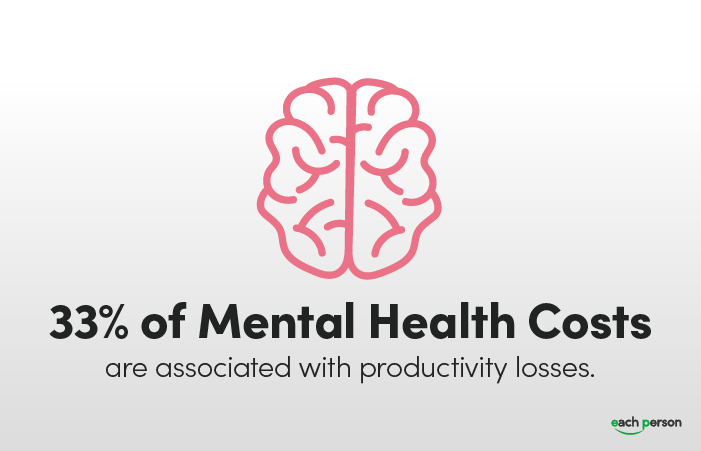
Mental health in the workplace, when ignored, can create costs for employers. Everyone has the right to decent and productive working conditions. For people living with mental health, this can make it hard for them to achieve (Gabriel and Liimatainen, 2000). It is critical for human resource departments and managers to recognise these associated costs within the workplace.
Everyone has some level of mental health all the time, just like physical health. This is possible without being a person living with a mental illness. Mental illness refers to a wide range of mental health conditions – disorders that affect your mood, thinking and behaviour. Examples of mental illness include depression, anxiety disorders, schizophrenia, eating disorders and addictive behaviour.
This blog will seek to examine the costs of mental health in the workplace and the obstacles it presents for individuals. Additionally, this bog examines the current mental health state and solutions to encourage a healthy working environment.
Costs of mental health in the workplace
Individuals with untreated mental illness who go to work, do so with an illness that impairs them physically, mentally and emotionally. Mental illness can significantly reduce a person’s working capabilities. In turn, this leads to absenteeism, sick leave, reduced productivity, reduced performance and additional stress for employees. It can also lead to presenteeism, which is working whilst sick. Consequently, all of this impacts the business. Common mental health illnesses among adults are in relation to anxiety and depression (Scahill, 2000).
It was mentioned that 33% of mental health costs are associated with productivity losses. This includes unemployment, disability and lower work performance (Narrow et al., 2002). The United Nations estimates that 25% of the population are impacted by the three causes of disability: cardiovascular, musculoskeletal and mental health disorders. The costs associated with mental health are:
- Direct costs of welfare services and treatment
- Indirect costs to those who are not directly affected e.g., colleagues
- The opportunity cost of income forgone due to incapacity
Obstacles mental health presents for employees
Furthermore, barriers arise due to mental health. For example, social exclusion may arise and is hard to overcome. Individuals with mental health illnesses might have feelings associated with shame, fear and rejection. Subsequently, this could lead to them feeling isolated and alone, especially at work. Globalisation and entering a new technology innovation era presents a vast array of new organisational structures and processes. Moreover, this also presents other aspects that can impact employees’ wellbeing and mental health.
Current mental health state
Research found that roughly 50-60% of adults with mental illness do not receive the services they require (Peck, 2002). Untreated mental health can create a snowball effect in terms of physical, social and emotional wellbeing. Therefore, it is imperative for organisations to be accounting for mental health and providing support for their employees.
Productivity loss due to people living with mental health have been quantified. Research has shown that more workers are absent due to stress and anxiety compared to physical illness or injury (Kessler, 2005).
Employees with depression report their productivity at 70% of their peak performance with approximately 32 incremental workdays lost to presenteeism for individuals with major depressive disorders.
How can we overcome the negative stigma associated with mental health?
The World Health Organisational declared physical health is not the only absence of disease. Physical, emotional, financial, intellectual and spiritual wellbeing encompasses good health. Furthermore, this reflects a positive state for individuals to thrive.
The issue of people living with mental health can be neglected, which does not help those individuals living with mental illness. Employers can assist by building cultures of health at the workplace, promoting health and safety. Furthermore, this can enhance performance and reduce feelings of isolation among employees with mental health (Goetzel et al., 2018).
What is a culture of health?
Establishing a culture of health and wellbeing at work creates an environment where employees feel valued, supported and stimulated to perform at their best (Ronald et al., 2005). Reward and recognition programs can help team members feel appreciated and respected, enhancing a collaborative organisational culture. In turn, this could reduce employees feeling alone if they are living with mental illnesses as they feel supported by their organisation.
Workers are more productive when they perceive workplace health support from their employer (Ronald et al., 2005). An environment that rewards creativity, teamwork, safety and resilience to organisational changes can encourage employee engagement.
Finally, healthy company cultures acknowledge that human beings cannot function at 100% all day. The development of a mental health “how-to” guide can provide employees with guidance. This could be especially useful for small and medium-sized enterprises that do not have the allocated resources to implement a robust program. Additionally, low-cost programs also support building and maintaining mentally healthy workplaces. A Wellbeing Hub can also be an effective way to promote healthy working environments.
To find out more about how Each Person can improve your mental health support in the workplace, visit eachperson.com or contact us at [email protected].
If you enjoyed this article, follow us on social media to stay up to date with our latest blogs and news.
LinkedIn: Each Person
Twitter: @_EachPerson
Instagram: @_eachperson